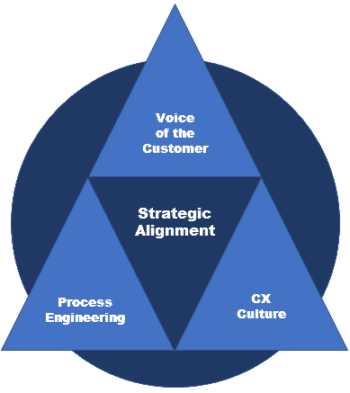In this article I’ll explain the components needed in place to elevate an organization’s Customer Experience. I won’t go too far in depth into the four parts but rather provide an overview of how they work together with a brief explanation of what they are. Following, in a continuation of this series of articles, I’ll explain with more specificity how these work (and work together), as they each deserve their own writings.
- CX Strategy and Corporate Strategy Alignment
Before we begin, we must ensure that our CX Strategy is aligned with our overall Corporate Strategy. Many CX practitioners, and surely, many business leaders simply define this as “Putting the Customers First” or other broad and sweeping declarations. While surely this is stated with all seriousness and setting aside those who simply pay the concept lip-service, it’s quite a bit more complicated than that. Actually aligning CX and Corporate strategies involves a lot of work and in some instances, organizational soul-searching. Often through the exercise of alignment, companies and departments even end up revisiting and revising their corporate strategies when it’s discovered that their Mission and/or Vision aren’t compelling from the perspective of their Customers. It’s a lot more nuanced than it looks and is truly foundational to the entire enterprise. This step must be done first if any of the operational efforts listed below are to have a positive impact.
- Learning via the Voice of the Customer
Once the CX and Corporate Strategies are aligned, we can move on to actually building out the structures that are necessary to do the work of elevating your CX. Regardless of what sort of organization we’re talking about, and regardless of the segmentation of Customers, we can’t improve the CX without first listening to and understanding what our Customers say about our current products and/or services and what they’d prefer to see from them. Generally speaking, this is rooted in the Voice of Customer (VoC) program. But much as with the Alignment step above, the VoC is much more than it appears. Volumes can be (and have been!) written about VoC and how to best execute this step. One common factor of successful programs, however, is that, much as with the offerings of your organization themselves, you meet your Customers where they are: Different segments require different vehicles for VoC; and even within those segments, different points along the journey require different methods of determining the Customers’ voices. Simply put: VoC is not just surveys. It’s much, much more than that.
- Deploying Process Improvement
If all you do with your VoC is report it to leadership, then CX is like the weather: Everybody talks about it but nobody ever does anything to improve it. It’s a waste of time and resources to build out a VoC program but then not put any effort into taking action as a result of what you learn. What’s more, it’s really an insult to your Customers to ask them for their opinion (say, on a survey, or through a feedback forum) and not take their recommendations to heart and act on them. Process Engineering (PE) is a great vehicle for providing that improvement. Whether it’s Lean, Six Sigma, or any other approach, the key to a good VoC program is using it, not just deliberating it. Leverage those insights to guide you in changing how you do business to better serve your Customers. Acting on these insights is really the ‘second shoe’ to drop. After all, that’s why we’re all here.
- Building and Supporting a Customer-Centric Culture
A comprehensive VoC program and robust Process Engineering endeavor is a good start, but without the supportive force of a Customer-centric culture within your organization, you may just be talking-the-talk. They say that Culture eats Strategy for breakfast. Well, Culture will wash it down with your CX if you let it. Best to make sure your organization’s culture is centered on an affinity for and dedication to satisfying your Customers’ needs and aligning your internal processes and policies with that Customer-centered Strategy you spent so much time building in Step 1 above. The keys here are enablement, empowerment, and encouragement. Enable your team members with the tools needed to do the job of delivering Customer-first experiences; empower them to address needs at the level closest to the Customers, and encourage them by walking-the-walk of prioritizing your PE efforts not simply on saving money or resources but improving the top-line CX numbers.
As I wrote above, there’s much more to each of these four components of a successful CX program, and each component deserves much more consideration. Here is just an introduction to those. Look for more to come, with deep-dives into these steps as well as more discussion on how they support each other and work together.






